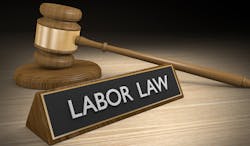Labor Department Jumps into the Joint Employer Issue while NLRB’s Decision Faces Challenge
David Weil, head of the Labor Department’s Wage and Hour Division, once again has indulged his preference for ruling by decree instead of relying on rulemaking procedures that require public participation.
Weil unilaterally declared that most companies using staffing agencies are joint employers of temporary workers under federal wage and hour laws. Prime targets for DOL enforcement in this area are the warehouse and logistics, construction, agricultural, janitorial, staffing and hospitality industries, he said.
Days after Weil issued his declaration, a legal challenge was filed in federal appeals court seeking to overturn the National Labor Relations Board’s decision broadening joint employer status for temp staffers when it comes to union organizing elections.
Weil’s administrative fiat was issued on January 20 in the form of a 15-page “agency interpretation.” Because he claims his statement only interprets existing regulations, Weil holds it does not require going through the usual procedural steps, including consideration of public comments, which federal agencies must follow when developing new rules.
Last year a similar interpretation was issued by Weil declaring that the vast majority of independent contractors are in reality company employees under wage and hour laws.
“Protecting workers in fissured workplaces—where there is increasingly the possibility that more than one employer is benefiting from their work—has been a major focus for the Wage and Hour Division in recent years,” Weil writes in his most recent agency interpretation, while neglecting to mention that it also has been an obsession with the nation’s labor unions. “In a nutshell, joint employment exists when a person is employed by two or more employers such that the employers are responsible, both individually and jointly, for compliance with a statute.”
Weil said his division will find joint employment “expansively,” interpreting the definition of joint employment to be “as broad as possible” including what he calls “horizontal” and “vertical” employment relationships. Horizontal joint employment exists when an employee works for two different companies but the companies are related, he says. Vertical employment happens in a staffing agency or contractor relationship where the employee works at one company but is employed by a separate company.
“The key takeaway here is that the DOL wants to find employment relationships,” notes attorney Todd Lebowitz of the law firm of Baker & Hostetler LLP. “Where such relationships do not seem to exist, newly created standards can make them exist. It is so because we say it is so.”
Lebowitz adds, “Companies that benefit from nonemployee labor, whether directly or indirectly, should carefully assess their relationships under these newly articulated standards. Those companies deemed to be joint employers can find themselves liable for payroll mistakes made by contractors over whom they exert little or no control.”
Immediate reaction from employer groups was blistering. “The Labor Department’s concept of a joint employer is even worse than what we’ve seen from the NLRB,” asserts David French, senior vice president of National Retail Federation. “Lawyers are already saying it’s only going to lead to more litigation. Congress has to stop the spread of this Orwellian big brother approach to government before it can go any further.”
Rep. Tim Walberg (R-Mich.), chairman of the House Workforce Protections Subcommittee, says, “This is part of a larger effort that will threaten the livelihoods of small business owners and destroy opportunities for workers and entrepreneurs to succeed in today's economy.”
NLRB Joint Employer Ruling Challenge
Last year the NLRB handed down its own landmark joint employer decision holding that staffing firm employees working at an organization being organized by a union are eligible to cast votes in a representation election.
A subsidiary of Browning-Ferris Industries of California included in its workforce about 240 workers supplied to BFI by a staffing firm called Leadpoint Business Services. The Teamsters union argued that BFI and Leadpoint were joint employers of those employees, who should be allowed to participate in the vote.
Until last year’s board decision, in order to be declared a joint employer a company needed to exert direct and immediate control over matters such as the temp workers’ hiring, firing, discipline, supervision and direction. In last year’s decision the board held that joint employer liability exists simply because at some point in the future the company could choose to exert such control if it wished to do so.
This potential change in control can exist for any company that contracts with another to perform work for it, including parent companies and subsidiaries, franchisors and franchisees, leasing employers and temporary services providers, and contractors and subcontractors.
The NLRB decision was considered so outrageous that legislation introduced in both houses of Congress to overturn it managed to attract the support of some Democrat members.
The decision allowed the Teamsters election at Browning-Ferris to proceed, and it was determined that a majority of the employees approved union representation. The company then refused to bargain with the union, which led to the finding it had engaged in an unfair labor practice. By challenging this latest decision Browning-Ferris has now brought the joint employer decision before a court.
Last year OSHA also adopted a similar course of action when it directed inspectors to collect information from franchisors and their franchisees expressly for the purpose of finding joint employer relationships in the pursuit of health and safety enforcement violations.
About the Author

David Sparkman
founding editor
David Sparkman is founding editor of ACWI Advance (www.acwi.org), the newsletter of the American Chain of Warehouses Inc. He also heads David Sparkman Consulting, a Washington D.C. area public relations and communications firm. Prior to these he was director of industry relations for the International Warehouse Logistics Association. Sparkman has also been a freelance writer, specializing in logistics and freight transportation. He has served as vice president of communications for the American Moving and Storage Association, director of communications for the National Private Truck Council, and for two decades with American Trucking Associations on its weekly newspaper, Transport Topics.
